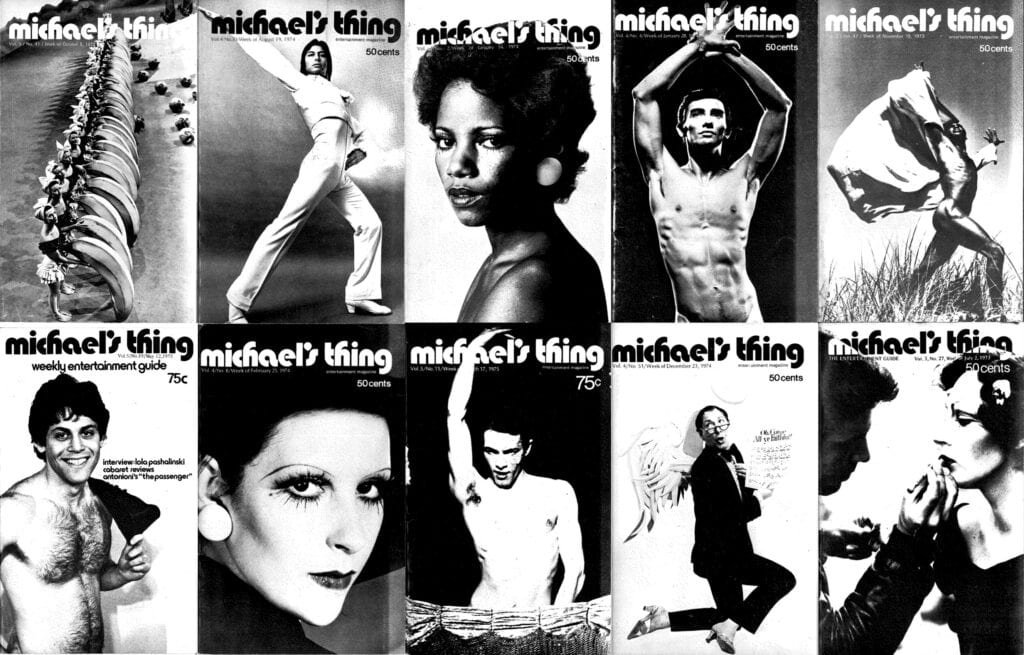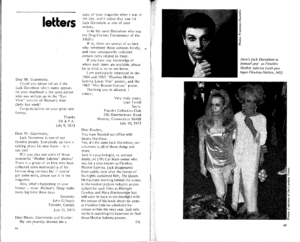A Taste of Honey: Preserving the Queer Legacy of ‘Michael’s Thing’
This post is written by Maddie DeLaere, an Archival Collections Management Graduate Student Worker. She is completing the NYU/LIU Dual Degree program, pursuing a Masters in Food Studies alongside an MLIS.

Collage of Michael’s Thing covers. Left to Right, Top to Bottom: 1973, Vol. 3, No. 41; 1974, Vol. 4, No. 33; 1974, Vol. 4, No. 2; 1974, Vol. 4, No. 4; 1975, Vol. 5, No. 19; 1974, Vol. 4, No. 8; 1975, Vol. 5, No. 11; 1974, Vol. 4, No. 51
Jack Doroshow / Flawless Sabrina Papers; MSS 594; Boxes 14-17; Fales Library and Special Collections, New York University.
Sometimes, when a new collection is processed – materials sifted, organized, and removed to distill groupings of items that represent someone’s career or an organization’s life – something special and unexpected can emerge: a collection the donor kept themselves. This time, it was quite exciting. Amidst Jack Doroshow’s (also known as drag queen, Flawless Sabrina) boxes of personal journals, project files, cultural ephemera, and photographs from films, shows, and performances were stacks of issues of a now rare, once ubiquitous, weekly magazine.
Michael’s Thing, a queer culture guide published weekly from 1970-2000, exemplifies the ability of cultural artifacts to all too easily be lost to the abyss. Despite its significance, its longevity, and its prolific publishing, a Google search of Michael’s Thing will yield nearly no related results. One might find a couple of short blog posts, some thumbnail images of cover pages from eBay listings, or university library special collections catalogs merely stating they have a few issues. That’s the “thing” with using search engines as research tools. Information about Michael’s Thing is likely hidden in the dusty crevices of the web, but because of lack of searchability, these websites are ghosts. Unfortunately, in this case, digging in library databases and digital archives reveals little more.
But Michael’s Thing lives on in the memory of those who made it, those who read it, those who saw it sold in bars, bathhouses, and clubs. Someone could pick it up for 50 cents (more in later years) and finally have the insider knowledge of where to go, who to see, and what’s going on in the gay community. At the time, the queer community was in a contentious relationship with the societal structures around it and the only way to stay in the know was through word of mouth or personal experience. Michael’s Thing strived to change that. Founded by Michael Giammetta in 1970, the year after the Stonewall Riots, Michael’s Thing joined the burgeoning queer press of the ‘60s and ‘70s. Gay rights activist and writer Karla Jay explains in a 2019 interview that the thought was, “the only way to have the power of the press was to create the press ourselves.”1
This collection within a collection contains 113 issues, mostly from the years Doroshow contributed, which is lucky, because he wrote when the magazine was at its height in the early to mid ‘70s. NYU’s collection of these publications extends from 1972-1987, with most issues being from 1973-1975. It remains part of Jack Doroshow’s Papers, in New York University’s Special Collections.
Throughout its 30-year span of being published, Michael’s Thing went through various changes in editors, columns, and cover styles, but always served the community as a culture guide meant “to inform, advise, intrigue, entertain, and stimulate,” as cheekily claimed in an in-magazine advertisement.2 It called out to readers from the stand, a glossy chapbook adorned with artistic cover photos of scantily clad men (typically adult film stars) or iconic figures in the scene like Patti Labelle, Gypsy, Tally Brown, or Miss Toni Lee, queen of drag strippers.

Advertisements in Michael’s Thing, 1972; Jack Doroshow / Flawless Sabrina Papers; MSS 594; Boxes 14-17; Fales Library and Special Collections, New York University.
Inside, the average issue of Michael’s Thing featured photospreads with cover boys, occasionally fully nude, and reviews of their movies or “skin flicks,” but also so, so much more: political columns, arts and entertainment criticism (from popular movies and music to cabaret and opera), horoscopes, gay news, goings on about town, and bar and restaurant guides. Many Michael’s Thing columnists used pseudonyms like Angelo D’Arcangelo, Rose March, and Kitty Klaws to ensure their ability to continue writing within and outside the queer press. The politics column, written by Joe Kennedy in the ‘70s, contained articles like “How To Get A Job If You’re Gay,” “The Gay Self Defense School,” and “How the Media Sees Us,” among other movement developments and exposés of political figures.3 A running column in the ‘80s called “Girls About Town” expanded the magazine’s intentional demographic to be more inclusive of the lesbian community. Features like “Notes on the Gay Sensibility,” by Charles Choset or “Which Way Is Gay” by Marco Vassi explore the nuance and complexity of gay life and the Gay Liberation Movement, offering poignant cultural critique matched with poetic expression. 4

Letters about Jack Doroshow, 1973; Jack Doroshow / Flawless Sabrina Papers; MSS 594; Boxes 14-17; Fales Library and Special Collections, New York University.
The “Michael’s Choice” section featured up-and-coming performers Giammetta himself pegged as soon-to-be-stars and where one could find them performing. Gossip columns spoke of who was seen at what club, followed by safety advice, all in the same breath. The late Jack Doroshow, collector of these magazine issues, contributed to Michael’s Thing often throughout 1973-1975 with a column called “FLASH,” providing paragraph-long newsflashes covering stories like the new location of a gay NYC church, a case of police harassment in Chicago, the start of a gay radio broadcast in Detroit, or the American Psychiatric Association removing homosexuality from the category of mental illness. He eventually wrote film reviews and feature articles, calling Chinatown (1974) “glamorous to death” and referencing drag as “a world of screaming, swishing, and painting dishing.”5

Bar guide; Jack Doroshow / Flawless Sabrina Papers; MSS 594; Boxes 14-17; Fales Library and Special Collections, New York University.
The bar guide was another integral part of the magazine. Just before the magazine’s start it was still illegal to sell alcohol to gay people, illegal to dance with those of the same gender, and sodomy laws were far from being reformed. The gay bar as we know it today was just beginning to blossom. “Underground” bars, at times mafia-run, treating the gay community well was necessary for safe congregation. These bars needed patrons and gay people needed to know where to go. Michael’s Thing was the mediator. The magazine received an outpouring of support from these local bars, thankful for the business and eager to buy an advertisement in the next issue. Giammetta ran scores of these ads within issues, the overwhelming majority of which were bars, restaurants, and clubs in the area. (The Club Baths, a Manhattan bathhouse, advertised on the back of almost every issue in NYU’s collection!) The bar guides were such a hit that Michael’s Thing began including mini bar and restaurant guides for other US states called “clip-a-guide.” Readers could cut out these dotted border guides for states like Kansas, where they could visit Jack’s by the Tracks in Wichita, or Mississippi, where two of the six bars listed for the state were at Holiday Inns, or Delaware, to scope out the scene at Dog House.
By introducing a gay-run magazine to the New York media market, Michael’s Thing brought the prior “invisible gay city” out from underground. From coverage of the first pride parades, to the development of a federal gay civil rights bill under the 1964 Civil Rights Act, to the whole course of the HIV/AIDS epidemic, Michael’s Thing wrote for and in turn documents a scene that was all too often dismissed by mainstream media.6 Personal anecdotes of joy sit next to stories of injustice alongside tales of mischief. Flipping through the pages is like experiencing an immersive history book.
Michael’s Thing provided a valuable and consistent source of information for readers at the time, and provides an incredibly valuable documentary source for us now. It reminds us that the Gay Liberation Movement is not and has not been a linear progression, but many zig-zags. It grew immensely through the ‘70s and beyond, but during this period The New York Times went back and forth on their allowance of the use of the term “gay,” in many places anti-discrimination laws for sexual orientation were still not in place, and it was still extremely difficult for a gay bar to acquire a liquor license. In the last five decades, the Gay Liberation Movement has made many more zig-zags and there is no doubt that Michael’s Thing contributed to its progress.

The Club Baths Advertisement; Jack Doroshow / Flawless Sabrina Papers; MSS 594; Boxes 14-17; Fales Library and Special Collections, New York University.
Michael’s Thing lives in archives — and surely some home basements — across America, usually in queer periodicals collections like the LGBT Community Center National History Archive and the Kroch Library of Rare Books & Manuscripts at Cornell University. These collections actually have substantial runs of the publication, but they are the outliers. Now, thanks to The Jack Doroshow / Flawless Sabrina Papers (MSS 594), it lives too at NYU in 113 preserved issues, presenting, as Michael himself says, “all kinds of views, controversies, bouquets and brickbracks, and, yes, a taste of honey.”7
You can view these issues by making an in-person research appointment with NYU Special Collections here.
- Perry Brass and Karla Jay, hosts Michael Bronski, Tobin Low, and Kathy Tu, “A History of the Queer Press” Library Talks, New York Public Library (podcast), June 2, 2019, accessed October 17, 2023, https://www.nypl.org/blog/2019/06/01/history-queer-press.
- Michael’s Thing, 1982, Vol. 12, No. 5.
- Michael’s Thing, 1974, Vol. 4, No. 18.
- Michael’s Thing, 1973, Vol. 3, No. 41; 1973, Vol. 3, No. 44
- Michael’s Thing, 1974, Vol. 4, No. 26; 1973, Vol. 3, No. 39
- David Farber and Beth Bailey, “’Adults Only’: The Construction of an Erotic City in New York during the 1970s,” in America in the Seventies, Lawrence: University Press of Kansas, 2004, 141.
- Michael’s Thing, 1972, Vol. 2, No. 52